
Assessing the health and resilience of urban trees is a crucial concern for arborists, landscape managers, and municipal authorities. Remote sensing, in-situ monitoring, and citizen science techniques offer powerful tools to monitor tree conditions at scale. Integrating these data sources with advanced predictive modeling, geospatial analysis, and time-series forecasting enables comprehensive evaluation of urban forest health.
Tree Health Monitoring
Accurately tracking the vitality and longevity of individual trees within the urban canopy is a complex challenge. Traditional methods have relied on periodic visual inspections by trained arborists. However, this labor-intensive approach struggles to keep pace with the expansive tree populations found in many cities.
Remote Sensing Techniques
Advances in aerial and satellite imagery have revolutionized urban tree health assessment. Multispectral sensors can detect subtle variations in leaf pigmentation, canopy density, and other biophysical indicators that signal stress or decline. Applying machine learning algorithms to these high-resolution datasets allows for automated, large-scale tree condition mapping. For example, a recent study by TriCounty Tree Care used drone-captured imagery and predictive modeling to identify early-stage pest infestations across a municipal forest network.
In-Situ Measurements
While remote sensing provides citywide coverage, ground-based monitoring remains essential for validating these insights and capturing nuanced, tree-level data. Arborists can utilize portable sensors to measure variables like trunk diameter, sap flow, and soil moisture – key indicators of individual tree health. Integrating this field data with the remote sensing analytics creates a powerful, multi-scalar assessment of urban forest conditions.
Citizen Science Approaches
Engaging the local community through citizen science initiatives taps into a vast network of tree observers. Apps that enable residents to report tree damage, pests, or other concerns provide real-time, on-the-ground intelligence to supplement professional monitoring. Coupling these crowdsourced observations with urban forest inventory databases can reveal granular spatial patterns and temporal trends.
Data Science Methodologies
Extracting meaningful insights from the diverse, multi-sourced datasets required for comprehensive urban tree health evaluation calls for advanced data science techniques.
Predictive Modeling
Machine learning algorithms can analyze the complex relationships between environmental factors, management practices, and tree health indicators. By training models on historical datasets, arborists can forecast the future condition of individual trees or entire neighborhoods, enabling proactive intervention. For instance, predictive models might identify which street trees are most vulnerable to drought stress under projected climate change scenarios.
Geospatial Analysis
Integrating tree health data with detailed geospatial information – including land use, infrastructure, socioeconomic variables, and more – reveals critical spatial patterns and interdependencies. Geostatistical techniques like kriging can interpolate conditions across an urban area, highlighting hotspots of tree decline or resilience. Overlaying this intelligence with municipal asset inventories allows for targeted, data-driven management decisions.
Time-Series Forecasting
Analyzing longitudinal trends in urban tree health is essential for understanding system dynamics and anticipating future challenges. Time-series modeling approaches, such as Autoregressive Integrated Moving Average (ARIMA) models, can identify seasonal patterns, detect anomalies, and project future trajectories. This informs proactive, adaptive management strategies to ensure the long-term sustainability of the urban forest.
Environmental Factors
A range of environmental stressors can impact the health and longevity of trees in urban settings, necessitating a holistic, systems-level understanding.
Climate Impacts
As the climate changes, urban trees face increasing threats from heat waves, drought, and other extreme weather events. Integrating high-resolution climate projections with tree health data can elucidate the vulnerabilities of different species and inform climate adaptation planning. For instance, a recent study found that certain native oak varieties exhibited greater resilience to predicted temperature and precipitation shifts in the Midwest U.S.
Soil Conditions
The often-compromised soils found in cities – compacted, contaminated, or lacking essential nutrients – can severely constrain tree growth and vitality. Comprehensive soil testing, coupled with spatial analysis of urban land use patterns, helps arborists target interventions like structural soils, biochar amendments, or enhanced irrigation to optimize belowground conditions.
Pest and Disease Dynamics
Invasive insects, fungal pathogens, and other pests pose an ever-present threat to urban trees. Monitoring the spread and prevalence of these threats, in conjunction with factors like climate and management practices, enables early detection and strategic treatment. Predictive modeling of pest/disease outbreaks is a critical component of proactive urban forest management.
Urban Forest Management
Leveraging the wealth of data and analytical capabilities described above, urban forest managers can develop robust, evidence-based strategies to sustain the health and resilience of the city’s trees.
Tree Inventory Systems
Comprehensive, spatially-enabled tree inventories form the foundation for data-driven urban forestry. Integrating these databases with geospatial analysis and visualization tools allows managers to track individual tree conditions, maintenance histories, and ecosystem service contributions over time. This empowers strategic decision-making around planting, pruning, and removal priorities.
Maintenance Strategies
Predictive modeling of tree health, combined with real-time monitoring, enables proactive, tailored maintenance regimes. By anticipating issues before they arise, arborists can optimize the timing and targeting of treatments like irrigation, fertilization, and pest/disease control. This approach maximizes the return on investment for urban forestry programs.
Sustainability Planning
Evaluating the long-term, systemic health of the urban forest is crucial for ensuring its continued ecological, economic, and social benefits. Time-series forecasting, combined with scenario planning, helps managers adapt strategies in response to emerging threats and community needs. Integrating these insights with municipal planning processes ensures the urban forest remains a resilient, sustainable asset for generations to come.
In conclusion, the rich array of data science tools and techniques available today equip urban forest managers with unprecedented capabilities to assess, monitor, and optimize the health of city trees. By embracing these innovative approaches, TriCounty Tree Care and other industry leaders are poised to safeguard the vitality of urban forests – critical green infrastructure that enhances community resilience, environmental quality, and human well-being.


